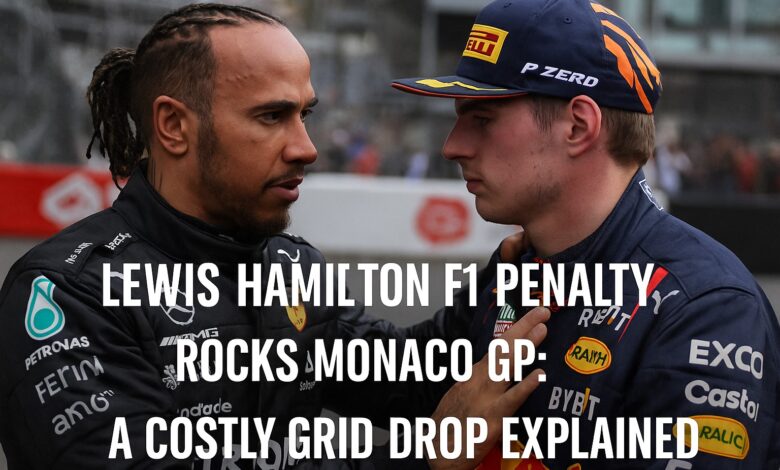Lewis Hamilton F1 Penalty Rocks Monaco GP: A Costly Grid Drop Explained

Lewis Hamilton F1 Penalty: What Happened in Monaco Qualifying
The Lewis Hamilton F1 penalty at the 2025 Monaco Grand Prix sent shockwaves through the paddock and fanbase alike. The seven-time world champion, now driving for Ferrari, was penalized three grid positions after an incident in Q1 qualifying where he impeded rival Max Verstappen. What initially seemed like a minor mistake quickly escalated into a headline-grabbing controversy involving team communication, driver awareness, and the razor-thin margins that define modern Formula 1.
In a season already brimming with intensity, this latest twist adds even more drama to Hamilton’s ongoing battle at the front of the grid. Let’s explore the full details of the incident, the aftermath, and how it ties into other F1 Lewis Hamilton penalty controversies.
Understanding the Penalty: What Went Wrong
The Qualifying Incident
During Q1 at the Monaco Grand Prix, Lewis Hamilton was on a cool-down lap approaching the Massenet corner. At the same time, Max Verstappen was on a flying lap, looking to set a competitive time. Due to a miscommunication from Hamilton’s race engineer, Riccardo Adami, Hamilton was incorrectly told that Verstappen was also on a slow lap.
Relying on that information, Hamilton did not yield or move off the racing line, causing Verstappen to abort his lap. The stewards reviewed the footage and telemetry and concluded that Hamilton had impeded Verstappen, affecting his ability to complete a fast lap.
The Stewards’ Decision
After investigating the incident, the FIA stewards awarded Hamilton a three-place grid penalty, stating that the responsibility to avoid impeding falls ultimately on the driver, regardless of team input. This ruling dropped Hamilton from P4 to P7 on the starting grid, significantly altering his race strategy and potential points haul.
Team Communication Failure: Who’s to Blame?
Engineer Error at Ferrari
Hamilton’s new role at Ferrari in the 2025 season came with the challenge of adapting to a new team and communication structure. His engineer, Riccardo Adami, made a critical error in reporting Verstappen’s status on track. Believing Verstappen to be on a cooldown lap, Hamilton maintained his line through Massenet, unintentionally obstructing the Red Bull driver.
Driver Responsibility Still Applies
While fans and analysts sympathized with Hamilton, the rules are clear—even if a team makes a mistake, the driver must ensure they are not blocking another competitor on a hot lap. This rule has been a consistent part of the FIA’s regulations for years and has caught out several drivers in the past.
Reactions From the Paddock
Hamilton’s Response
After the session, Hamilton acknowledged the mistake and personally apologized to Verstappen. He emphasized that the error was unintentional and stemmed from flawed information. Hamilton’s handling of the situation showed professionalism and a deep respect for his competitors.
Verstappen’s Perspective
Verstappen accepted the apology but remained frustrated by the lost opportunity in Q1. He noted that while he didn’t believe Hamilton acted maliciously, the interference cost him a potential pole position.
Ferrari’s Statement
Ferrari admitted their role in the mistake and promised to review internal protocols to prevent future miscommunication. The team recognized the impact of their error not just on qualifying, but also on the broader championship picture.
Impact on the Championship Battle
Grid Drop Consequences
In a tightly contested season, a three-place grid drop can make a significant difference. At a circuit like Monaco—where overtaking is notoriously difficult—starting in P7 instead of P4 severely limits a driver’s chances of reaching the podium, let alone winning.
Lost Points and Momentum
This F1 Lewis Hamilton grid penalty cost valuable points in the Drivers’ and Constructors’ Championships. With every race mattering in the modern Formula 1 landscape, the setback at Monaco may have long-term implications on Hamilton’s title bid.
F1 Lewis Hamilton Penalty History: A Broader Pattern?
Not the First Time
This isn’t the first instance of a Lewis Hamilton penalty in F1. Over his lengthy career, Hamilton has faced numerous penalties—from track limits to unsafe re-entry to blocking during qualifying. However, most observers agree that this particular incident was a rare case of team miscommunication rather than driver negligence.
Comparisons to Other Penalties
Looking at previous F1 Lewis Hamilton penalties, it’s clear that the FIA tries to maintain consistency. In similar blocking incidents involving other drivers, three-place grid penalties have been the norm. This ensures fairness across the grid, even when top names are involved.
The Role of Technology and Judgment
Real-Time Decision-Making
Modern F1 teams rely heavily on real-time data, GPS tracking, and radio communication to guide drivers. However, split-second decisions still depend on human judgment, and errors like this highlight the fragile balance between machine and man in elite motorsport.
Should the Rules Change?
Some have called for a revision of the rules, suggesting that team miscommunication should carry less severe consequences for the driver. However, the current framework prioritizes on-track safety and fairness, making such changes unlikely in the near future.
What’s Next for Hamilton and Ferrari?
Regaining Momentum
After this penalty, Hamilton and Ferrari must regroup. The focus will shift to maximizing performance in upcoming races and ensuring tighter communication between driver and pit wall. Mistakes like this can derail a season, but they also serve as learning moments for both driver and team.
Pressure to Perform
As the season progresses, the pressure mounts. Ferrari’s dream of winning a championship with Hamilton hinges on consistency, error-free execution, and capitalizing on rivals’ mistakes—not gifting them opportunities through penalties.
Conclusion: Lessons From the Lewis Hamilton F1 Penalty
The Lewis Hamilton F1 penalty at Monaco serves as a cautionary tale in Formula 1. It underscores the importance of accurate team communication, personal responsibility on track, and the significant consequences of even minor errors in elite competition. While Hamilton’s reputation remains largely intact, the incident is a reminder that even the best can be caught out when systems fail.



